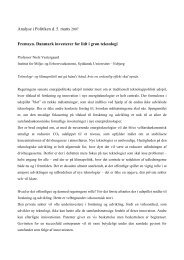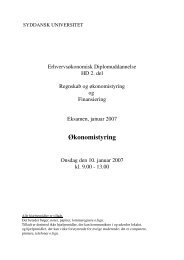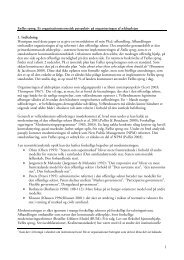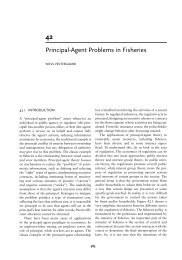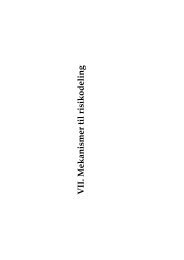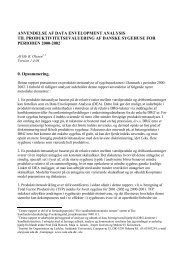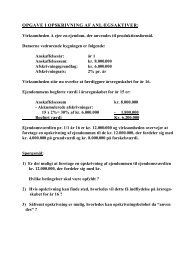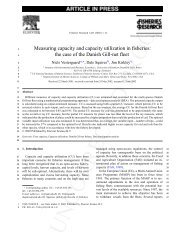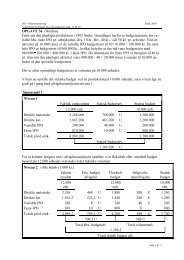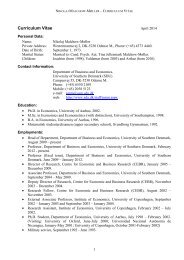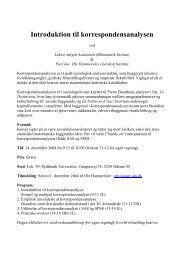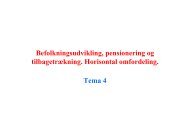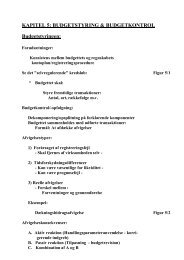expected, much due to the many splits <strong>and</strong> “wars <strong>in</strong> the top” on the Polish Right. The experiencefrom be<strong>in</strong>g activists <strong>in</strong> opposition to the old system, phrases like “civil society aga<strong>in</strong>st the state” <strong>and</strong>the image <strong>of</strong> a united society fight<strong>in</strong>g aga<strong>in</strong>st the authorities <strong>and</strong> their imperial supporters, i.e. theSoviet Union, were no longer a decisive factor after the fight aga<strong>in</strong>st the old system had been won.Furthermore, transformation <strong>and</strong> democratisation <strong>in</strong> Pol<strong>and</strong> has been <strong>in</strong>fluenced by agents <strong>and</strong>structures external to the Polish state constitut<strong>in</strong>g important structural causes for the collapse <strong>of</strong> theold system <strong>and</strong> the formation <strong>of</strong> the new. The <strong>in</strong>fluence <strong>of</strong> external agencies such as <strong>in</strong>ternationalf<strong>in</strong>ancial organisations <strong>and</strong> human right movements was mediated through domestic social <strong>and</strong>political <strong>in</strong>stitutions 39 . As far as the first years are concerned we mostly had to do with a political”muddl<strong>in</strong>g through”. The “party’ist” type <strong>of</strong> democracy has been less pronounced <strong>in</strong> Pol<strong>and</strong> than <strong>in</strong>the Czech Republic <strong>and</strong> Hungary because <strong>of</strong> low party <strong>in</strong>stitutionalization, fragile multiparty system<strong>and</strong> party fragmentation. <strong>Parties</strong> <strong>in</strong> all CEEC’s tended to be cadre configurations, not massorganisations. Under those circumstances non-democratically elected <strong>in</strong>stitutions like trade unions<strong>and</strong> church <strong>and</strong> national banks may obta<strong>in</strong> a stronger political position, thereby limit<strong>in</strong>g theautonomy <strong>and</strong> the consolidation <strong>in</strong> the political sphere, <strong>and</strong> the significance <strong>of</strong> political parties <strong>and</strong>party systems.From the outset the polarisation <strong>of</strong> Polish politics followed four l<strong>in</strong>es:• between Solidarity <strong>and</strong> post-communists, i.e. on the structural level• <strong>in</strong>side the Solidarity movement (“the wars <strong>in</strong> the top”), i.e. on <strong>in</strong>stitutional level• for or aga<strong>in</strong>st the president (Walesa), i.e. on actor level• for or aga<strong>in</strong>st the Balcerowicz plan I, i.e. the economic chock-therapy, i.e. on policy-levelThe first type <strong>of</strong> polarisation was dom<strong>in</strong>ant just at the time <strong>of</strong> the “break through” <strong>in</strong> 1989 <strong>and</strong> hasnever been de-freezed. The dom<strong>in</strong>ant model underly<strong>in</strong>g Solidarity, that <strong>of</strong> civil society aga<strong>in</strong>sttotalitarianism, underm<strong>in</strong>ed Solidaritys own struggle as Solidarity was not able to go beyond theculture <strong>and</strong> the history go<strong>in</strong>g back to 1980-81 <strong>and</strong> identify new conflicts <strong>and</strong> alternative futuresunder post-communism. Later <strong>in</strong> the 1990s, i.e. after the formation <strong>of</strong> the formation <strong>of</strong> the SLD-PSL government <strong>in</strong> 1993, a new political divide, “for <strong>and</strong> aga<strong>in</strong>st the president” (Walesa) ga<strong>in</strong>edmomentum. The “cohabitation” between AWS led government <strong>and</strong> post-communist president hasbeen difficult <strong>and</strong> never found the optimal form. However, the later president Aleks<strong>and</strong>erKwasniewski did not make the same serious mistakes as Lech Walesa. In short, structural factors,i.e. the legacy <strong>of</strong> the past, soon obta<strong>in</strong>ed a dist<strong>in</strong>ct subjective side. To better underst<strong>and</strong> the mean<strong>in</strong>g<strong>of</strong> Solidarity, we also have to <strong>in</strong>clude the <strong>in</strong>ternal constitution <strong>of</strong> the movement itself, i.e.<strong>in</strong>stitutional factor.At the 1991 election an extreme multiparty system emerged with no less than 27 different politicalgroups represented <strong>in</strong> parliament. The non-party system characteristics were strik<strong>in</strong>g until the 1993election. Adversary politics, governmental overload, overparliamentarization, party’ism, party splits39 F. Steves, “Pol<strong>and</strong> <strong>and</strong> the <strong>in</strong>ternational system: external <strong>in</strong>fluences on democratic consolidation”, Communist <strong>and</strong>Post-Communist Studies 34 (2001):339-352.44
<strong>and</strong> creation <strong>of</strong> new parties <strong>and</strong> party alliances were impressive. In the first years many aimed tomarg<strong>in</strong>alise <strong>and</strong> even exclude the “post-communist” SdRP <strong>and</strong> the left party alliance SLD from theparty political scene. At the same time SLD tried its best to be accepted as a relevant st<strong>and</strong>ardpolitical party <strong>and</strong> as soon as possible become a member <strong>of</strong> the social democratic SocialistInternational (SI).The cleavages <strong>in</strong>herited from the period before 1989 were reactivated at the presidential election <strong>in</strong>1995 <strong>and</strong> dur<strong>in</strong>g discussions about the new constitution <strong>in</strong> 1995 <strong>and</strong> 1996. The early freez<strong>in</strong>g <strong>of</strong> theold “We” versus “Them” discourse became an <strong>in</strong>surmountable obstacle for the establishment <strong>of</strong> ahistorical compromise between the “postcommunist” SLD <strong>and</strong> the social liberal Democratic Union(UD), the later Freedom Union (UW)). The national-accommodative system <strong>in</strong> Pol<strong>and</strong> had beenless suppressive than <strong>in</strong> most other CEECs, nonetheless, on the discoursive level the “We-Them”dist<strong>in</strong>ction rema<strong>in</strong>ed strik<strong>in</strong>g. As a result, at the mid 1990s Pol<strong>and</strong> moved closer to polarizedpluralism, <strong>in</strong> which case many relevant parties are present, i.e. parties with a big coalition potentialor an effective veto power, at the same time the ideological distances between the parties wereconsiderable.From the outset the formation <strong>of</strong> political parties <strong>and</strong> party systems followed the same l<strong>in</strong>e as <strong>in</strong> theother Central European countries; first the creation <strong>of</strong> broad movement parties, e.g. Solidarity, <strong>and</strong>the reconstruction <strong>and</strong> later the creation <strong>of</strong> “post-communist parties”, e.g. SLD <strong>and</strong> PSL. The 1989election was followed by party-fragmentation <strong>and</strong> destructive ”wars <strong>in</strong> the top” <strong>in</strong> the Solidaritymovement between pragmatists <strong>and</strong> fundamentalists, <strong>in</strong> part caused by the new electoral law, whichhad no threshold requirement for representation <strong>in</strong> parliament. No consistent strategies for cop<strong>in</strong>gwith such conflicts (the conflict “between us”) were developed. Also the alliance between<strong>in</strong>tellectuals <strong>and</strong> workers soon disappeared. To sum up, the first stage <strong>of</strong> post-communism wasmarked by electoral volatility, party fragmentation <strong>and</strong> protest vot<strong>in</strong>g. Only the agrarian party PSLwas signified by mass party characteristics <strong>and</strong> several core voters. Furthermore, the boundariesbetween parties <strong>and</strong> <strong>in</strong>terest groups rema<strong>in</strong>ed porous, among others due to weak party<strong>in</strong>stitutionalisation.Pol<strong>and</strong> has been rich on polarisation <strong>of</strong> the reactive type, e.g. <strong>in</strong> the shape <strong>of</strong> a “for or aga<strong>in</strong>st theBalcerowicz plans”. The reactive polarisation was repeated <strong>in</strong> the case <strong>of</strong> privatisations, the wageregulation, the adm<strong>in</strong>istrative reform <strong>and</strong> the health reform etc. The explanation shall be found <strong>in</strong>the legacy <strong>of</strong> “output-articulation” go<strong>in</strong>g back to the “communist time”. The “wars <strong>in</strong> the top” wereharmful for the law mak<strong>in</strong>g process because the “wars <strong>in</strong> the top” were followed by “wars <strong>of</strong> laws”.As noted by Wlodzimierz Weselowski, the re-activization <strong>of</strong> cleavages expressed a plannedpolarisation <strong>of</strong> the political life from the Solidarity side 40 . As the economic growth <strong>and</strong> socialmobility decl<strong>in</strong>ed, group consciousness <strong>in</strong>creased <strong>and</strong> even tended to challenge the new postcommunistsystem. The refusal <strong>of</strong> cooperation with “post-communists” was ma<strong>in</strong>ly tactical asreferences to the common enemy <strong>and</strong> the common Christian values might suppress <strong>in</strong>ternaldisagreements <strong>and</strong> reduce popular dissatisfaction with the chosen economic <strong>and</strong> social policy. Like<strong>in</strong> most other CEEC’s a change was observed towards majoritarian democracy based on thepr<strong>in</strong>ciple that “the w<strong>in</strong>ner takes it all”.The 1993 election brought the ”post-communists” (SLD, PSL) <strong>in</strong> power ma<strong>in</strong>ly due to the lowparticipation at the elections <strong>and</strong> the decl<strong>in</strong>e <strong>of</strong> confidence <strong>in</strong> parliaments <strong>and</strong> polical parties.40 Wlodzimierz Weselowski, ”Aktorzy politycznej i demokracja”, <strong>in</strong> Grabowski <strong>and</strong> Mocek, 1997:67.45
- Page 3: “This provisional situation chara
- Page 6 and 7: marketisation and privatisationshor
- Page 8 and 9: purposes, are channels for “expre
- Page 10 and 11: the significance of strategic choic
- Page 12 and 13: presidentialism gave rise to “flo
- Page 14 and 15: antipolitics and reinforcement of a
- Page 16 and 17: In the late 1990’s elections most
- Page 18 and 19: determined primarily by “politica
- Page 20 and 21: politics and antipolitics, all sign
- Page 22 and 23: which attitudes to state regulation
- Page 24 and 25: Anti-communism has been defined in
- Page 26 and 27: elections and the Slovak communists
- Page 28 and 29: Cartel agreementsbetter representat
- Page 30 and 31: Basically the absence of clear cons
- Page 32 and 33: After 1989 different types of polit
- Page 34 and 35: complex project for transition unde
- Page 36 and 37: window of opportunity in spite of s
- Page 38 and 39: analyses of party institutionalizat
- Page 40 and 41: political messages and slogans. Thu
- Page 42 and 43: well established party culture may
- Page 46 and 47: Furthermore, the polarisation on el
- Page 48 and 49: Finally, Solidarity can also be con
- Page 50 and 51: whole, on the one side an authorita
- Page 52 and 53: The economic recession and the grav
- Page 54 and 55: election defeat more cooperation an
- Page 56 and 57: The formation of AWS can be conside
- Page 58 and 59: group. RS AWS constituted the Chris
- Page 60 and 61: According to the original plans the
- Page 62 and 63: values. According to Rybicki, as so
- Page 64 and 65: AWS should fight against all types
- Page 66 and 67: 2001 parliamentary election, howeve
- Page 68 and 69: and workers voted ZChN. At the 1993
- Page 70 and 71: The League has been considered as a
- Page 72 and 73: establishment like than LPR’s. Th
- Page 74 and 75: jobs in rural areas, especially sma
- Page 76 and 77: industrial policy. According to the
- Page 78 and 79: pressurizing the government to give
- Page 80 and 81: democrats, thereby locating itself
- Page 82 and 83: To conclude, the Freedom Union (UW)
- Page 84 and 85: Polish middle class. Thus, in Janua
- Page 86 and 87: such as KSCM and KSS in The Czech R
- Page 88 and 89: The SLD leaders were mainly recruit
- Page 90 and 91: the falling popular support for pri
- Page 92 and 93: innovation was formation of the pol
- Page 94 and 95:
place after talks with each applica
- Page 96 and 97:
Has the Left any freedom of manoeuv
- Page 98 and 99:
medicine, changes in the labour cod
- Page 100 and 101:
The Labour Union (UP), Democratic U
- Page 102:
Nevertheless, before that had taken



